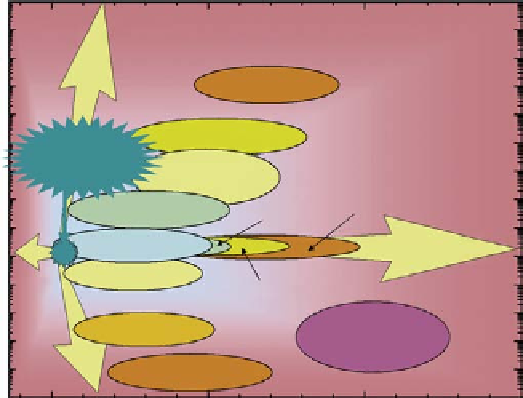Geoscience Reference
In-Depth Information
and the energy required in such processing. Bioprocessing can produce very useful
materials using minimal energy but for only limited species, size, shape, and location.
Although the artificial processing can produce almost all materials, it consumes high
energy.
Figure 10.2
shows the PT map of various materials-processing techniques
[17]
.Accordingto
Figure 10.2
, the hydrothermal processing of advanced materials
can be considered as environmentally benign. Besides, for processing nanomaterials,
the hydrothermal technique offers special advantages because of the highly controlled
diffusivity in a strong solvent media in a closed system.
The features involved in the in situ fabrication of materials by hydrothermal pro-
cessing cover the direct or single-step formation of shaped/sized/deposited/oriented
particles or ceramics with a minimized consumption of energy, resulting in any
desired shape and size. Since the system acts as a closed flow system, thus makes
it easy for charging, separation, cycling, and recycling, we can achieve high deposi-
tion rate, and the entire process is highly versatile. The processes falling into the
category of soft solution processing can be seen in
Figure 10.3
. It shows advanced
materials processing involving a single-step versus multistep processes
[18]
. The in
situ fabrication of the materials is the present trend in materials processing without
involving postsynthesis treatment. This is the greatest advantage of hydrothermal
processing, which facilitates the in situ size, morphology control, and also surface
modification.
The important step in the processing of fine particles of advanced materials is
the use of surfactants and chelates to control the nucleation of a desired phase,
such that the phase homogeneity, size, shape, and dispersibility could be achieved
10
14
10
13
10
12
10
11
10
10
10
9
10
8
10
7
10
6
10
5
10
4
10
3
10
2
10
Environmental
load
Environmental
load
Shockwave
High pressure
Solution
process
High-pressure
solution
Melt
Solvothermal
Sol-gel
Environmental
load
Environmental
load
Hydrothermal
CVD
Solid-state reactions
Sputtering
Plasma
Evaporation
1
−
273
0
1000
2000
3000
Temperature (
°
C)
Figure 10.2 Pressure
temperature map of materials processing techniques
[17]
.


